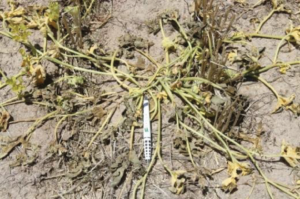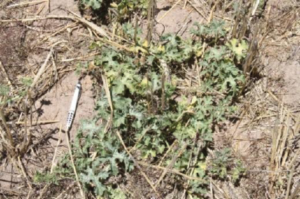
SUMMER FALLOW WEED CONTROL
USE ALL THE TOOLS
| Version 2 | Date January 2020 | Reference 44 |
- The right herbicide and rate for the weed.
- The right adjuvant to maximise droplet survival, leaf coverage and penetration, whilst reducing drift. Depending on the adjuvant used, initial herbicide efficacy and time taken for complete control can vary by up to 50%.
- The right boomspray setup – coarse nozzles for drift control and high water volume for best coverage.
- Indicates that in glyphosate and ester mixtures, high emulsifier loaded oil-based adjuvants such as ENHANCE® and ANTIEVAP® provide the best efficacy on a range of summer weeds such as melons, fleabane and feathertop Rhodes.
- Benefits of the double knock – importance of coverage and leaf penetration for non- translocated herbicides.
SACOA has invested heavily in independent field research throughout Australia, assessing the effectiveness of various adjuvants with common summer herbicide mixtures on key weeds such as fleabane, melons and feathertop rhodes grass – with some surprising results. This independent work has been conducted with extensive industry collaboration to answer key questions;
- Droplet survival – what does it mean?
- What’s the best balance between coverage and leaf surface penetration?
- What are the efficacy differences between adjuvants – oils vs seed oils vs soyal phospholipids?
Getting herbicides onto and into weed leaves can be tough in summer conditions with drift, evaporation and run-off all contributing to loss. Increased droplet survival allows herbicides more time to enter into weeds, so getting herbicides to work well under summer conditions requires a balance between leaf surface coverage and penetration.
Key Findings
Our coverage analysis work found key differences between adjuvants;
- Soyal phospholipid-based products can increase droplet size and reduce evaporation as well as provide water conditioning benefits but provide little leaf surface penetration.
- Seed oils such as PLANTOCROP®and X-SEED® tend to produce larger droplets due to their increased viscosity and tend to be more effective with Group A herbicide mixtures on grass weeds due to their penetrative properties.
- Oil based emulsions, which contain varying degrees of surfactant such as ENHANCE® and ANTIEVAP®, provide a balance between leaf surface coverage and penetration and are therefore best suited to tank mixes of translocated and contact herbicides such as glyphosate and and ester.
What does that mean for destroying summer weeds fast?

| Figure 1: Impact of adjuvants on a leaf surface. (Source: SACOA) |
Back in November 2014 SACOA published results from our 2012 independent field research indicating ENHANCE® and ANTIEVAP® provided the quickest brownout on melons compared to other adjuvants such as LI700. Our latest research, including some of the newer adjuvants to the market supports this.
Key Findings
- In Garlon + Ester + Ally mixes, clear rate response between ENHANCE® at 0.5% and 1.0% 8DAT
- In Glyphosate + Garlon + Ester + Ally + ENHANCE® @ 1.0% provide the quickest brownout 8DAT
- Soyal phospholid-based products provided relatively poor control in garlon only mixtures at all assessment
% Melon Control
| Chart 1: Common melon control mixutres with different adjuvants | Applied 8.12.14 Temp 30.4C, RH 32% Delta T 11.5, Nozzles 6 x AI110015 @ 100L/Ha | Melon stage – 20-30cm diameter. (Source: Trial SE145 – Agvivo Agronomy T. Boyes Quairading Dec 2014) |

| Image 2: Glyphosate 1.5L + Garlon 80ml + 2.4D 500ml (lv ester 680) + Ally 5g + ENHANCE® 1.0% 8DAT on 16 December 2014. (Source: SACOA) |

| Image 3: Untreated control, 8DAT on 16 December 2014. (Source: SACOA) |
Key Findings
- In mixtures of Glyphosate + Ester + Ally the oil-based adjuvant with high emulsifier loading (ENHANCE® 1.0%) and non-ionic surfactant (WETTA 1000) provided the best control
% Fleabane Control
| Chart 2: Fleabane Control with different adjuvants with Glyphosate 2.0L + 2,4D 800ml + Ally 5g | Applied 8.12.14 Temp 32.6, RH 32% Delta T 13, Nozzles 6 x AI110015 @ 100L/Ha | Fleabane – 20-30cm high – flowering. (Source: Trial SE146 – Agvivo Agronomy T. Boyes Quairading Dec 2014). |
Key Findings
- Gramoxone 1.5L applied 14 days after the initial application improved control in all treatments.
- Using an oil-based adjuvant with greater penetrant properties such as ENHANCE® proved superior to non-ionic surfactants in mixtures with Gramoxone, averaging 10% greater control in all
Double Knock Effect
| Chart 3: Fleabane control using a double knock strategy | Applied 8.12.14 Temp 32.6, RH 32% Delta T 13, Nozzles 6 x AI110015 @ 100L/Ha | Fleabane – 20- 30cm high – flowering (Source: Trial SE146 – Agvivo Agronomy T. Boyes Quairading Dec 2014). |
- SACOA Fallow Trial, December 2014
- Agvivo Demonstration Trial Avon Valley, June 2014.
